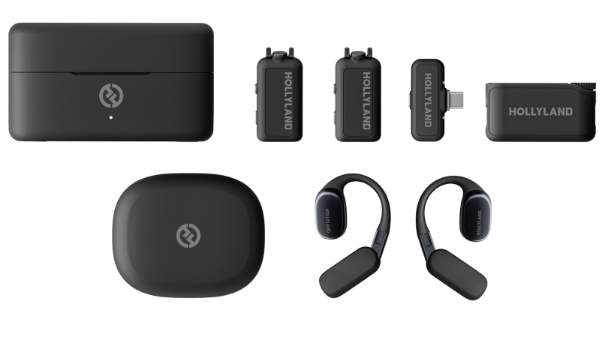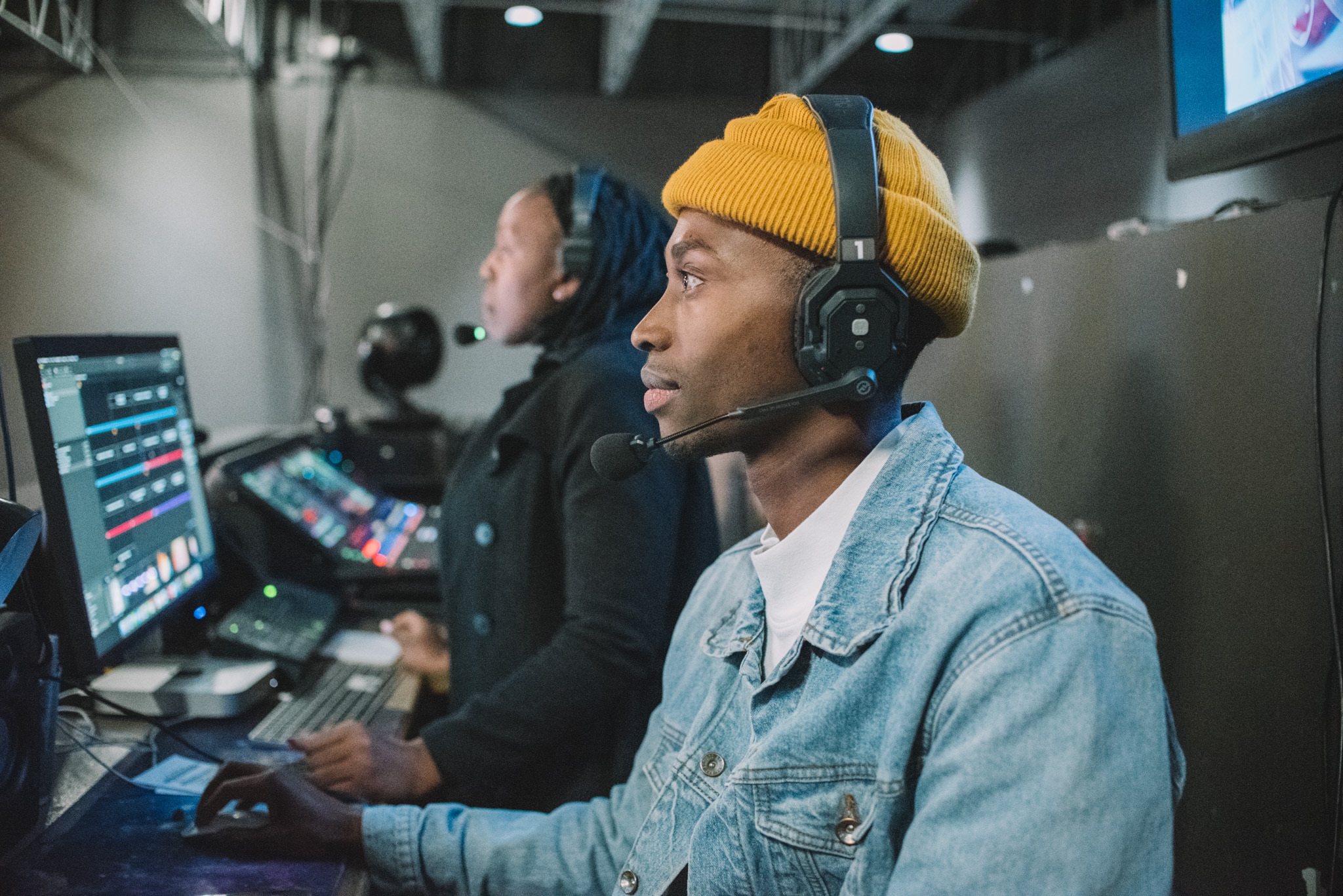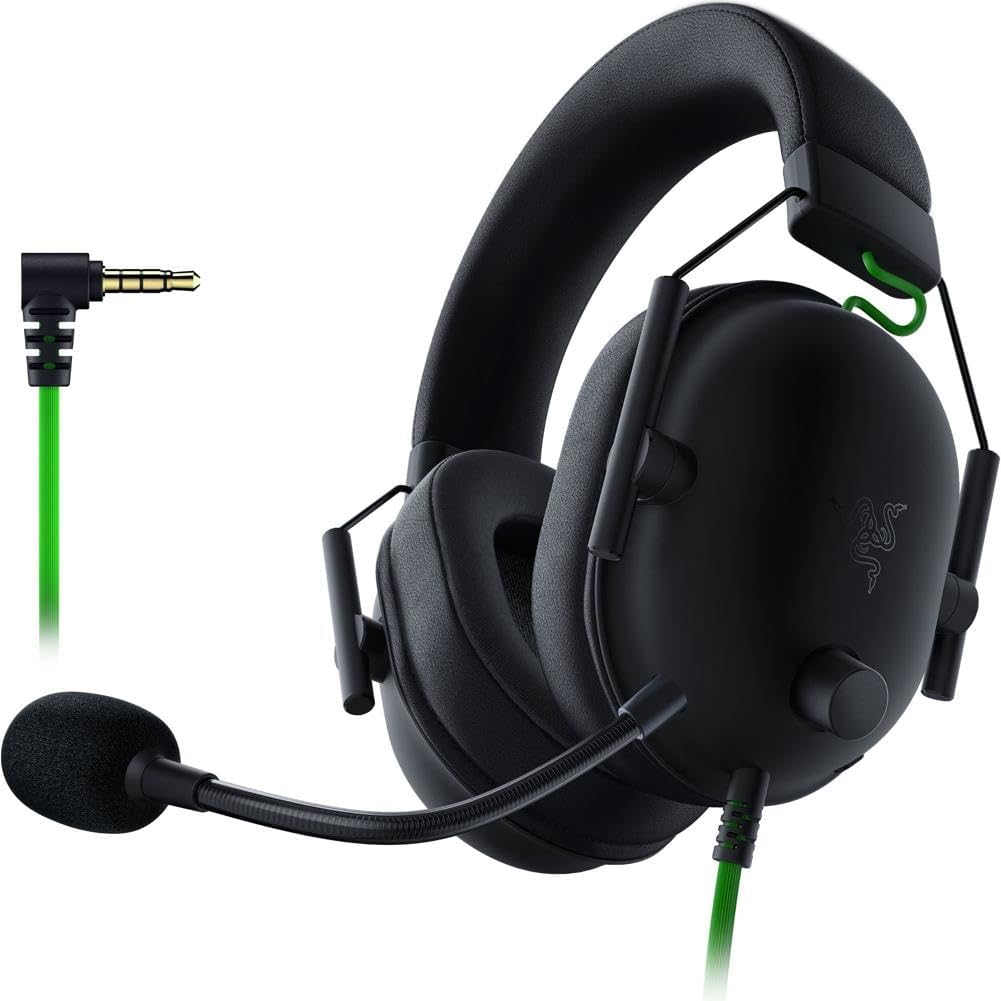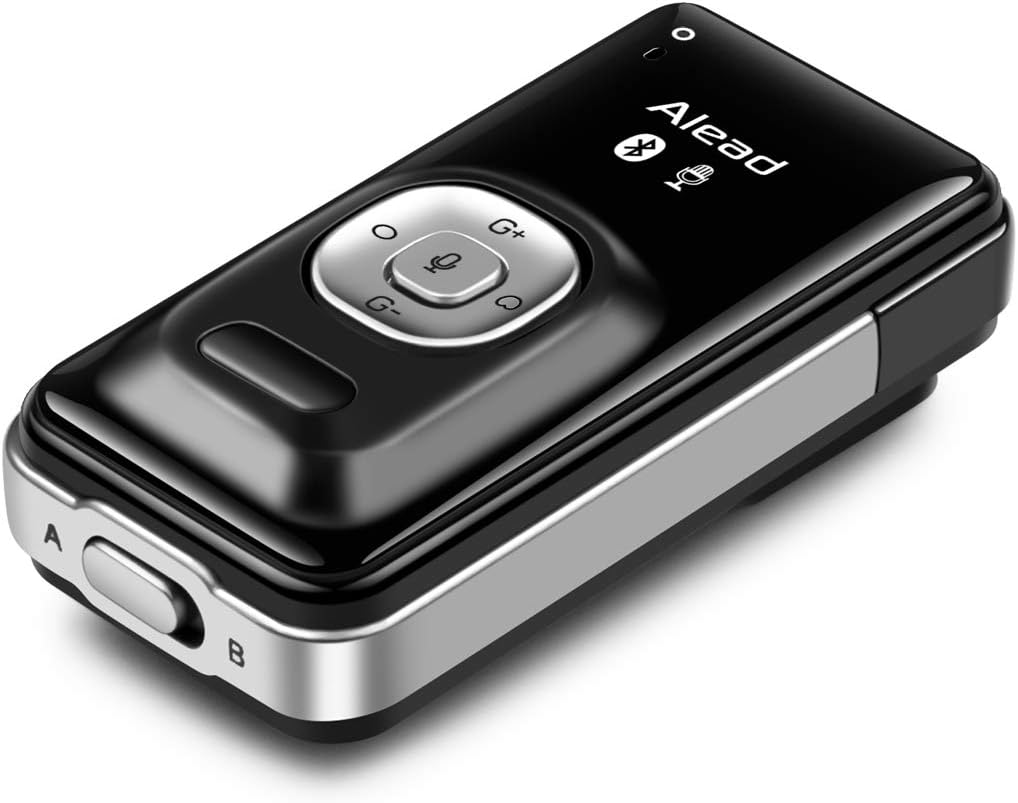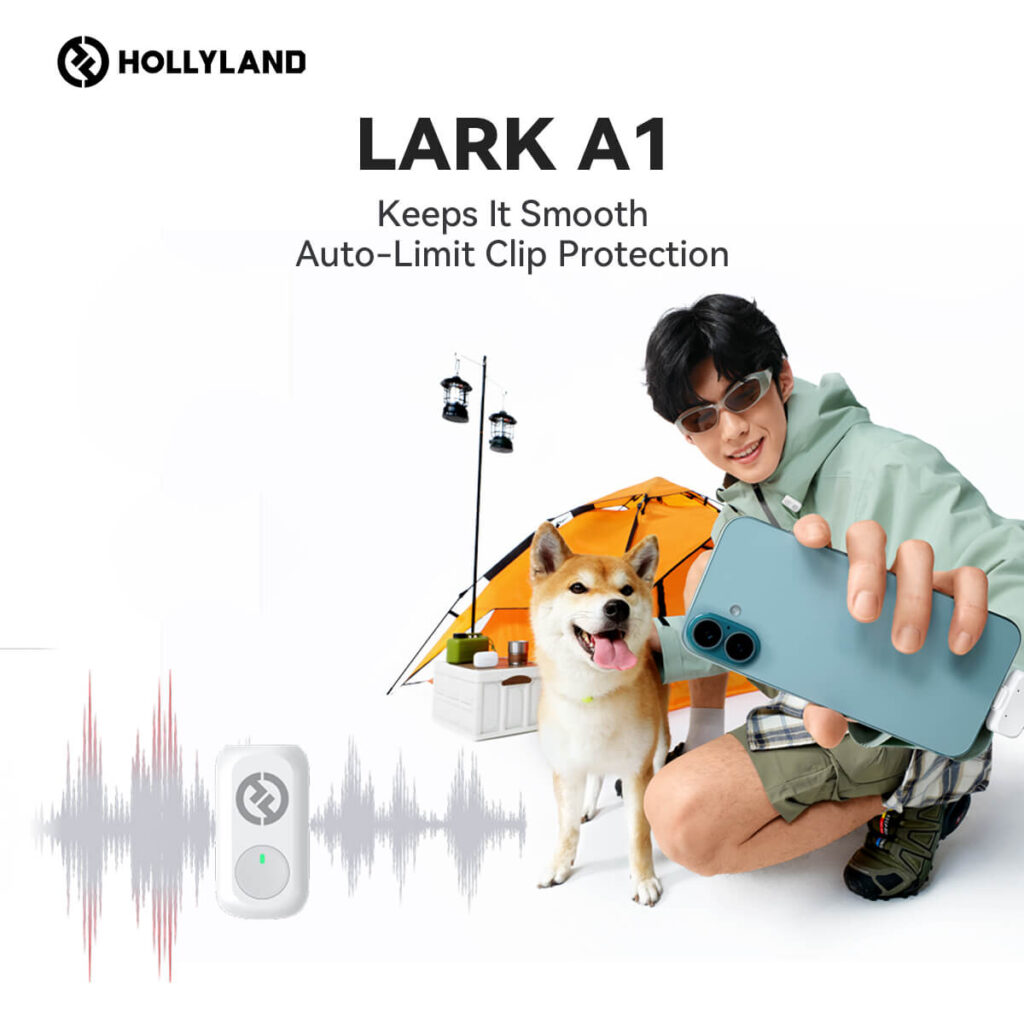So, you want your music or vocals to truly impress? Then don’t settle for poor gear. A good microphone for recording can make all the difference. Luckily, the biggest names in audio are here to help. From RODE to Shure and all the way to Neumann and AKG, this article covers the very best. Keep reading to find out which ones deserve a spot in your studio.
Why Trust Us?
As an industry-leading brand in wireless audio, Hollyland’s official blog offers valuable insights from our engineers, audio experts, and real creators to help readers select the right microphone system. Our recommendations are based on lab tests, hands-on use, and objective comparisons with the world’s top brands, ensuring reliable and honest advice for users.
Top Picks at a Glance
| Model | Mic Type | Frequency Response | Maximum SPL | Best For | Price |
| Shure SM7B | Dynamic | 50Hz – 20kHz | Not specified | Isolation | $439 |
| Audio-Technica AT2020 | Condenser | 20Hz – 20kHz | 114 dB | Reliability | $119 |
| RODE NT1 | Condenser | 20Hz – 20kHz | 132 dB | Low self-noise | $249 |
| Neumann TLM 102 | Condenser | 20Hz – 20kHz | 144 dB | Small studios | $726.53 |
| AKG C214 | Condenser | 20Hz – 20kHz | Not specified | Tone | $374.65 |
| Shure SM58 | Dynamic | 50Hz – 15kHz | Not specified | Detailed vocals | $109 |
| Electro-Voice RE20 | Dynamic | 45Hz – 18kHz | Not specified | Broadcast audio quality | $449 |
| RODE NT1-A | Condenser | 20Hz – 20kHz | $137 dB | Brightness | $249 |
| Shure SM57 | Dynamic | 40Hz – 15kHz | Not specified | Instruments | $109 |
| AKG C414 XLII | Condenser | 20Hz – 20kHz | 140 dB – 158 dB | Multi-pattern control | $1118.99 |
| RODE NT1 5th Generation | Condenser | 20Hz – 20kHz | 142 dB | Professional setups | $243.90 |
| Shure MV7+ | Dynamic | 50Hz – 16kHz | 128 dB | Dual connectivity | $299 |
| Shure MV7X | Dynamic | 50Hz – 16kHz | Not specified | Portable | $199 |
| RODE M5 | Condenser | 20Hz – 20kHz | 140 dB | Stereo clarity | $179 |
| Aston Microphones Origin | Condenser | 20Hz – 20kHz | 127 dB | Vocal texture | $197.50 |
| RODE NT1 Signature Series | Condenser | 20Hz – 20kHz | 142 dB | Rich tonality | $159 |
| Blue Yeti | Condenser | 20Hz – 20kHz | 120 dB | Multipattern | $129.99 |
| FIFINE AmpliGame AM8 | Dynamic | 50Hz – 16kHz | Not specified | Starters | $44.99 |
| Maono A04 | Condenser | 30Hz – 16kHz | 120 dB | Cost-effective | $49.99 |
| Lewitt Pure Tube | Tube condenser | 20Hz – 20kHz | 132 dB | Rich vocals | $1499 |
| Shure SM7dB | Dynamic | 50Hz – 20kHz | Not specified | Built-in preamp | $549 |
| FIFINE K688 | Dynamic | 50Hz – 15kHz | 130 dB | Ease of use | $51.09 |
| Sennheiser Profile Mic | Condenser | Not specified | 125 dB | Handy | $115.99 |
NOTE: Prices are sourced from Amazon (US) and are subject to change over time.
List of Microphones for Recording: Detailed Review
1. Shure SM7B – Sounds Right Every Time

The Shure SM7B lets you tweak your tone easily. If you want clearer mids or less low-end rumble, it’s ready. Bass roll-off and presence boost controls help you get the right feel. A small graphic shows the setting, so no guessing! Moving your mic stand? No problem at all. Its air suspension shock isolation keeps those thumps out of your recording.
Specifications:
Polar pattern: Cardioid
Frequency response: 50Hz – 20kHz
Max SPL: Not specified
Self-noise (Equivalent Noise Level): N/A
Sensitivity: -59.00 dBV/Pa (1.12 mV/Pa)
Connector: 3-pin XLR
Pros:
- Clean and flattering sound quality
- Rejects background noise very well
- Solid and durable build
- Industry standard for professional audio
Cons:
- Needs a powerful preamp or gain booster
- Quite heavy for some mic arms
- Not ideal if you don’t speak close to the mic
Suitable for: Podcasting, vocal recording, streaming, broadcasting, voiceovers, untreated rooms, and content creation
Real review from Amazon: “No feedback or any issues whatsoever. Very easy to set up too. Might use it as a vocal mic for some of my songs as well! 10/10” — @Abbie Pincus
Price: $439
2. Audio-Technica AT2020 – Durable and Trusted

The Audio-Technica AT2020 is a condenser microphone. It handles high SPL well, so loud sounds stay clean. Perfect if you’re recording vocals, guitars, or even drums. It offers a wide dynamic range for more recording freedom. The low-mass diaphragm helps catch fast sound changes. That means sharper details with every take. Extended frequency response adds even more depth and clarity.
Specifications:
Polar pattern: Cardioid
Frequency response: 20Hz – 20kHz
Max SPL: 144 dB (1 kHz at 1% THD)
Self-noise (Equivalent Noise Level): 20 dB SPL
Sensitivity: -37 dB (14.1 mV) re 1V at 1 Pa
Connector: 3-pin XLRM-type
Pros:
- Durable build lasts for years
- Good value for the price
- Works well in studio or untreated rooms
- Plug-and-play setup with XLR
Cons:
- Sensitive to plosives and sibilance
- Picks up ambient noise without filters
- Initial setup may cause a hiss with some gear
Suitable for: Voice actors, streamers, YouTubers, podcasters, musicians, and beginners upgrading from USB mics
Real review from Amazon: “I’m a voice actor and streamer and with everything it picks up , it doesn’t pick up the computer fans , It grabs the clear clean audio of my voice.” -@Silent Wisdom
Price: $119
3. RODE NT1 – Suits All Vocals

The RODE NT1 keeps recordings clean and noise-free. With just 4.5 dBA self-noise, it captures every word clearly. Spoken word and narration sound natural and full. Its neutral tone suits almost any voice type. It also handles loud sounds up to 132dB SPL. If you want clarity with no harsh edges, this mic delivers that smoothly.
Specifications:
Polar pattern: Cardioid
Frequency response: 20Hz – 20kHz
Max SPL: 132dB
Self-noise (Equivalent Noise Level): 4.5 dBA
Sensitivity: -29.0dB re 1V/Pa (35.00mV @ 94dB SPL) +/-2dB @ 1kHz
Connector: XLR
Pros:
- Low self-noise for clean recordings
- Rugged metal body feels durable
- Excellent for vocals, instruments, and voiceovers
- Works smoothly with most audio interfaces
Cons:
- Heavy with a pop filter and shock mount attached
- Not ideal for untreated rooms
- May require a stronger mic stand for stability
Suitable for: Voiceover artists, podcasters, singers, audiobook narrators, YouTubers, streamers, and home studio musicians
Real review from Amazon: “The Rode NT1 is hands down one of the best microphones I’ve added to my studio. The clarity and detail it captures is incredible” — @frostbite
Price: $249
4. Neumann TLM 102 – Big Sound, Small Package

If silky vocals and sharp instruments are your thing, the TLM 102 makes sense. It delivers a clean, balanced tone with every take. The transformerless circuitry helps handle loud sounds without distortion. That’s perfect for drums or bold vocals. Plus, the quick transient response keeps guitars and brass crisp and detailed.
Specifications:
- Polar pattern: Cardioid
- Frequency response: 20Hz – 20kHz
- Max SPL: 144 dB
- Self-noise (Equivalent Noise Level): 12 dB-A
- Sensitivity: 11 mV/Pa
- Connector: XLR
Pros:
- Clear and balanced audio quality
- Small and solid build
- Great for vocals and instruments
- Honest sound reproduction
Cons:
- Picks up background noise easily
- Lacks upper treble boost
- Flat sound may lack brightness for some users
Suitable for: singer-songwriters, voice-over artists, podcasters, home studio vocalists, acoustic guitar recording, and spoken word creators, such as storytelling or narration
Real review from Amazon: “it was a big upgrade compared to all of the mics i ever bought my engineer loves it and my artist also i work with hiphop and dembow music and it sounds good” — @jerry11385
Price: $726.53
5. AKG C214 – Pure Tone in Every Take

The C214 comes with a premium-grade one-inch capsule. That means you get smooth and natural audio every time. It also has an integrated suspension system. This helps block out mechanical noise during recording. Works great when a neighbor slams a door or your chair squeaks mid-take. Keeps the focus on your voice, not the background drama.
Specifications:
Polar pattern: Cardioid
Frequency response: 20Hz – 20kHz
Max SPL: Not specified
Self-noise (Equivalent Noise Level): 13 dB-A
Sensitivity: 20 mV/Pa
Connector: Balanced XLR, 3-pin male
Pros:
- Smooth sound
- Solid metal build
- Handles mechanical noise effectively
Cons:
- Slightly sibilant highs on some voices
- Needs careful placement for best results
- Not ideal for low-output setups
Suitable for: Podcasting, streaming, vocal recording, instrument capture, home studios and beginners
Real review from Amazon: “I have 7 or 8 mid-price mics…and this one became my favorite overnight.” — @C. Moriarity
Price: $347.65
6. Shure SM58 – Bright Vocals, Clean Highs

If vocals are your main thing, the Shure SM58 makes sense. Its frequency response boosts the mids for vocal clarity. At the same time, it gently reduces the bass to avoid muddiness. Now, if you’re worried about breath sounds or windy spaces, no stress. The built-in spherical filter quietly handles those puffs and pops before they hit the mix.
Specifications:
Polar pattern: Cardioid
Frequency response: 50Hz – 15kHz
Max SPL: Not specified
Self-noise (Equivalent Noise Level): N/A
Sensitivity: –54.5 dBV/Pa (1.60 mV/Pa)
Connector: 3-pin XLR
Pros:
- Durable, strong build
- Works for studio vocals and instruments
- Balanced tone without sounding metallic
- Affordable professional quality
Cons:
- Output signal is very low
- Needs a preamp for best results
- No on/off switch
Suitable for: Live performers, vocalists, studio beginners, public speakers, church sound teams, comedians, and on-the-go musicians
Real review from Amazon: “Classic microphone, I use it for studio recording (crazy right?). This thing can survive nuclear war. It’s god a good frerquency response perfect for performing.” -@Hector Andres Mayoral
Price: $109
7. Electro-Voice RE20 – Classic Broadcast Sound

Looking for something that handles vocals with grace? The Electro-Voice RE20 has a smooth and natural tone that works great for voice recordings or podcasts. It sounds controlled, not harsh. The Variable-D technology helps reduce the proximity effect, so getting close won’t mess up the low-end. This keeps voices clean and balanced, even in tight spaces or small booths.
Specifications:
Polar pattern: Cardioid
Frequency response: 45Hz – 18kHz
Max SPL: Not specified
Self-noise (Equivalent Noise Level): N/A
Sensitivity: 1.5 mV/pascal
Connector: XLR
Pros:
- Very smooth and natural sound
- Excellent for untreated rooms
- Consistent sound with head movement
Cons:
- Heavy and bulky design
- Needs a powerful preamp or gain booster
Suitable for: Radio broadcasters, podcast hosts, voice-over artists, home studio users, acoustic guitar recorders, and content creators in untreated rooms
Real review from Amazon: “Was hesitant to pull the trigger on this mic because of the price tag, but it gets a smile out of me every time. It also makes for a great conversation starter in any online class or work meeting.” — @Ahmed
Price: $449
8. RODE NT1-A – Silky Airy Vocals

The RODE NT1-A can handle louder vocals without cracking. Perfect if you’re working with strong vocalists or high-energy speakers. It has a brighter tone than the NT1. So if you like breathy vocals or want more sparkle in the highs, it delivers what you’re looking for..
Specifications:
Polar pattern: Cardioid
Frequency response: 20Hz – 20kHz
Max SPL: 137 dB
Self-noise (Equivalent Noise Level): 5 dBA
Sensitivity: -32 dB re 1V/Pa (25 mV @ 94 dB SPL) +/-2 dB @ 1kHz
Connector: 3-pin XLR, balanced
Pros:
- Clear, warm, and crisp sound
- Handles plosives well, even without a pop filter
- Captures soft and loud vocals accurately
- Professional quality for home studios
Cons:
- Can sound harsh or nasal in untreated rooms
- Fragile and sensitive to moisture and dust
Suitable for: Home studio singers, hip hop vocalists, YouTube creators, amateur music producers, and voiceover artists
Real review from Amazon: “This microphone is very good for the price. I have used it in a small studio setting and I am very impressed.” — @Chuck
Price: $249
9. Shure SM57 – Benchmark for Instrument Recordings

Shure SM57 is a favorite for both instruments and vocals. It starts strong with a contoured frequency response that keeps everything pretty clean. Then comes the pneumatic shock-mount system, which is a boon for serious musicians. Why so? Because it reduces noise from hand movements while you’re smashing those snares.
Specifications:
Polar pattern: Cardioid
Frequency response: 40Hz – 15kHz
Max SPL: N/A
Self-noise (Equivalent Noise Level): Not specified
Sensitivity: -56 dBV/Pa (1.6 mV/Pa)
Connector: 3-pin XLR
Pros:
- Durable and road-ready build
- Great sound clarity and natural tone
- No phantom power needed
- Industry-standard mic
Cons:
- Not ideal for soft or quiet voices
- Requires gain-hungry preamps for some voice setups
Suitable for: snares and drums, performing live, producing in studios, managing church sound, playing rock music, and streaming with a powerful voice
Real review from Amazon: “The best bang-for-your-buck, versatile microphone you can use to get started. I have used it for guitar amps, acoustic guitar, drums, and occasionally vocals. The sound is professional and the design is robust.” — @Ian Steffancin
Price: $109
10. AKG C414 XLII – Many Patterns, Clear Peaks

The AKG C414 XLII gives you flexibility with 9 polar patterns (4 intermediate settings and 5 patterns). This means you can record in nearly any setting without switching microphones. If you prefer smooth recording without distortion, the built-in overload warning LED helps a lot. It flashes whenever the audio level gets too high, so you can adjust quickly and save your take from clipping.
Specifications:
Polar pattern: Cardioid, Figure 8, Hypercardioid, Omnidirectional, and Wide Cardioid
Frequency response: 20Hz – 20kHz
Max SPL: 140 dB and 158 dB with pad
Self-noise (Equivalent Noise Level): 6 dB-A
Sensitivity: 23 mV/Pa
Connector: Balanced 3-pin XLR (Male)
Pros:
- Excellent sound clarity
- Very low self-noise
- Multiple polar patterns
- Strong, durable build
Cons:
- Picks up room noise easily
- Needs a treated space for best results
- Slightly sensitive to plosives
Suitable for: Professional studio engineers, voiceover artists, podcast hosts, vocalists, acoustic musicians, and classical instrument recording
Real review from Amazon: “I own many mics and they all have their own characteristics. The standout characteristic of this microphone is it’s very low self-noise.” — @Max
Price: $1118.99
11. RODE NT1 5th Generation – When Legacy Meets Advancements

The RODE NT1 5th Generation updates the classic NT1 with clever improvements. It has a 32-bit float digital output. That means you can forget about clipping, even if things get loud. If you like smart tools, the built-in DSP supports APHEX audio processing. You can shape your sound with it easily.
Specifications:
Polar pattern: Cardioid
Frequency response: 20Hz – 20kHz
Max SPL: 142 dB
Self-noise (Equivalent Noise Level): 4 dBA
Sensitivity: -32 dB re 1 Volt/Pascal (25 mV @ 94 dB SPL) +/-2 dB @ 1 kHz
Connector: 3-pin XLR and USB
Pros:
- Excellent sound quality for the price
- Dual connectivity: USB-C and XLR
- Low self-noise with clear recordings
- Very sensitive and detailed capture
- Easy USB setup, no extra gear needed
Cons:
- No headphone jack for direct monitoring
- High sensitivity picks up background noise
- USB latency can be noticeable
Suitable for: Music producers, podcasters, voiceover artists, vocalists, audiobook narrators, and YouTubers
Real review from Amazon: “Love the quality of the sound I get and the versatility of the dual connectors.” -@Ejypnushi
Price: $243.90
12. Shure MV7+ – Powering Up the Podcast Game

The MV7+ features a sleek LED touch panel that feels modern and easy to use. It fits nicely into any setup, whether for streaming or recording. If your space isn’t quiet, the real-time Denoiser uses smart DSP to reduce background noise and keep your voice clean. To deal with plosives, the Digital Popper Stopper softens harsh bursts. Meanwhile, the built-in pop filter keeps everything camera-ready without bulky gear.
Specifications:
Polar pattern: Cardioid
Frequency response: 50Hz – 16kHz
Max SPL: 128 dB
Self-noise (Equivalent Noise Level): Not specified
Sensitivity: -55 dBV/Pa
Connector: 3-Pin XLR, USB-C
Pros:
- Crisp, warm, broadcast-ready sound
- Strong background noise rejection
- Reverb and vocal polish options
- Adjustable touch panel and mute
Cons:
- Touch panel can be overly sensitive
- No physical on/off switch
- Picks up minor desk movements and cable noise
Suitable for: Podcasting, gaming, streaming, voiceovers, home studios, and content creation
Real review from Amazon: “After six months of using the Shure MV7+ for my weekly podcast, I can confidently say this microphone delivers professional results with surprising ease of use.” — @Anna
Price: $299
13. Shure MV7X – Hybrid Solution for Multi-Person Recordings

Sprinkle a few characteristics of MV7 and SM7B, and voila! You get the Shure MV7X. It uses Voice Isolation Technology, which helps your voice stay super clear even if the room is noisy. The mic has a dynamic cartridge, cardioid pick-up pattern, and shock mount just like the MV7. It’s shaped like the SM7B and made for vocalists and podcasters.
Specifications:
Polar pattern: Cardioid
Frequency response: 50Hz – 16kHz
Max SPL: Not specified
Self-noise (Equivalent Noise Level): N/A
Sensitivity: -38 dB
Connector: XLR
Pros:
- Very portable and durable
- Easy to set up
- Great noise isolation
Cons:
- Needs loud speaking or close distance
- Has issues with Discord audio pickup
- Lacks the bass fullness of SM7B
Suitable for: Interviews, podcasts, and streaming
Real review from Amazon: “The sound quality is incredible, although it is a little tough to adjust the settings” — @Don Pikula
Price: $199
14. RODE M5 – Go-to Pair with Big Sound Energy

Hate hiss? Same here. The RODE M5 stays whisper quiet thanks to very low noise. Its 1/2 inch gold-sputtered cardioid condenser capsule captures crisp, clean audio with ease. Highs sparkle and lows hit deep, so nothing gets lost. Each matched pair is carefully selected with under 1 dB difference. It’s like having twin mics that always agree, making stereo sound smooth and balanced.
Specifications:
Polar pattern: Cardioid
Frequency response: 20Hz – 20kHz
Max SPL: 140 dB
Self-noise (Equivalent Noise Level): 19 dBA SPL
Sensitivity: -34 dB re 1V/Pa (20mV @ 94 dB SPL) ± 2dB @ 1kHz
Connector: XLR (balanced output: pin 2 +, pin 3 –, pin 1 ground)
Pros:
- Great stereo imaging when placed properly
- Compact and easy to carry
- Works well with instruments and vocals
- Matches well with popular audio interfaces
Cons:
- XLR cables and mic stands are sold separately
- Possible buzzing if placed near power cables
Suitable for: recording choirs, capturing acoustic instruments, school performances, stereo audio setups, church services, and home studio use on a budget
Real review from Amazon: “As a beginner in audio technology, I was hesitant about the cost of other options, but I have no regrets about these.” — @Javier Rodriguez
Price: $179
15. Aston Microphones Origin – Clean Audio, Solid Protection

Aston Microphones Origin has a wave-form spring head that bends. If it gets knocked, it returns to shape like nothing happened. This smart design also cuts off-axis noise during recording sessions. The mesh-knit pop filter is not some random add-on. It’s built right into the stainless steel head and blocks harsh puffs. It also keeps nasty signals away and can be washed anytime.
Specifications:
Polar pattern: Cardioid
Frequency response: 20Hz – 20kHz
Max SPL: 127 dB (for THD 0.5%)
Self-noise (Equivalent Noise Level): 18dB A-Weighted
Sensitivity: 23.7mV/Pa at 1kHz
Connector: XLR 3-Pin Male
Pros:
- Good proximity effect without crowding the mic
- Slim profile helps with pop filter placement
- Effective background noise rejection
- No need for perfect mic positioning
- Captures subtle voice details clearly
Cons:
- Slightly heavy
- Needs careful gain control for singing vocals
Suitable for: Voice-over artists, podcasters, acoustic guitar recordings, freelance producers, and singers
Real review from Amazon: “Just buy this mic. I heard about this from some serious engineers in Nashville and decided to give it a shot. I was not disappointed.” — @Steve
Price: $197.50
16. RODE NT1 Signature Series – Great for Almost Any Recording Setup

If you want your voice to shine without the chaos in the background, RODE NT1 Signature Series tight cardioid polar pattern helps reduce unwanted noise. But wait! The magic spell is not just for soft duets, but loud drums or screaming vocals can be recorded without a hitch. Why so? Because its 142 dB SPL handling won’t crack under pressure. At the end of the day, the sound has a bright top, detailed mids, and a warm bass, so everything feels balanced and rich.
Specifications:
Polar pattern: Cardioid
Frequency response: 20Hz – 20kHz
Max SPL: 142 dB
Self-noise (Equivalent Noise Level): 4 dBA
Sensitivity: -32 dB re 1V/Pa (25 mV @ 94 dB SPL) +/-2 dB @ 1 kHz
Connector: 3-pin XLR
Pros:
- Very easy to set up
- Strong volume output
- Durable and solid build
- Low background noise
- Professional look and feel
Cons:
- Occasional static or popping noises reported
- Some users prefer the older NT1 version
Suitable for: Vocalists, musicians, home studio owners, podcasters, voice-over artists, and content creators recording instruments like guitar, piano, and drums
Real review from Amazon: “Incredible sound and response. You’re getting a quality microphone, worth every penny and more.” -@Brian L. Gray
Price: $159
17. Blue Yeti – One Mic, Four Modes

The Blue Yeti packs power with its custom mic capsule array. Switch between 4 pickup patterns depending on what you’re recording. Plus, it lets you adjust the gain knob if things get a little too loud. Likewise, if you want quiet in a flash? Hit the instant mute button right on the mic. All the controls are rightly placed on the mic!
Specifications:
Polar pattern: Cardioid, stereo, omnidirectional, and figure-8
Frequency response: 20Hz – 20kHz
Max SPL: 120 dB
Self-noise (Equivalent Noise Level): Not specified
Sensitivity: Not specified
Connector: USB
Pros:
- Excellent sound quality
- Easy-to-use controls on mic
- Plug-and-play with no drivers
- Zero-latency headphone monitoring
Cons:
- Shock mount is expensive and hard to find
- Lowest sensitivity still picks up background noise
Suitable for: ASMR content, vocal duets, podcasting/interviews, and group music recordings
Real review from Amazon: “This mic is absolutely sweet. It really gets a job done. Be sure to stick around for some tips I have when using this bad boy.” -@Sean Tamura
Price: $129.99
18. FIFINE AmpliGame AM8 – Stylish Looks, Bright Sound

The AM8 gives off warm and natural audio, great for recording. Its square shape and RGB lighting add a creative edge to any setup. It works with both USB and XLR, which suits beginners and intermediate users. Then, there’s a touch-mute button that helps with quick silencing. Additionally, in the USB mode, the sidetone and level dials make voice control simple and smooth.
Specifications:
Polar pattern: Cardioid
Frequency response: 50Hz – 16kHz
Max SPL: Not specified
Self-noise (Equivalent Noise Level): N/A
Sensitivity: -50 +/- 3 dB
Connector: USB Type-C to Type-A 2.0 and XLR
Pros:
- Warm and clear voice reproduction
- Sturdy and well-balanced build
- Zero-latency headphone monitoring
- Works well in untreated rooms
Cons:
- RGB and mute don’t work in XLR mode
- Picks up background noise without a filter
- Not ideal for pro-level quality
Suitable for: Podcast and vocal recording, beginner streamers, budget-conscious content creators, casual video calls, and gaming setups with RGB preference
Real review from Amazon: “The audio comes through crisp and clear, giving a professional feel whether you’re gaming, chatting, or creating content.” — @Jbycz
Price: $44.99
19. Maono A04 – Easy Price, Work-Ready

Looking for an economical mic for enhanced recording? The Maono A04 has a 16mm large diaphragm condenser and a smart sound chipset. That means your voice can be recorded at a high-resolution 192kHz/24-bit. It helps your audio stay smooth and detailed. What’s more impressive is its heavy-duty, premium shock mount. It supports weights from 1kg to 1.2kg and helps keep the mic stable during setup.
Specifications:
Polar pattern: Cardioid
Frequency response: 30Hz – 16kHz
Max SPL: 120 dB
Self-noise (Equivalent Noise Level): Not specified
Sensitivity: -38 dBA +/-3 dBA (0dB = 1V/Pa at 1kHz)
Connector: USB A to B
Pros:
- Sturdy all-metal build
- Works on Mac, PC, and PS5
- Long USB cable
- Good for budget users
Cons:
- Slight white noise may develop
- Boom arm can flop if not tightened
- Doesn’t work with Zoom PodTrak P2
Suitable for: Recording, podcasting, streaming, voiceovers, singing, online teaching, gaming, and YouTube
Real review from Amazon: “I’m really satisfied with this Microphone! It looks great and was easy to set up.” — @Kitty
Price: $49.99
20. Lewitt Pure Tube – Vintage Warmth, Modern Clarity

If you love warm and clear vocal recordings, the Lewitt Pure Tube fits the bill. It uses a hand-selected 12AU7 ECC82 tube that gives a rich and silky tone. The revolutionary circuit design helps reduce noise and boosts clarity. This makes your voice sound more detailed and natural. Great for anyone chasing a clean studio sound without digital harshness.
Specifications:
Polar pattern: Cardioid
Frequency response: 20Hz – 20kHz
Max SPL: 132 dB
Self-noise (Equivalent Noise Level): 7 dB (A)
Sensitivity: 28.2 mV/Pa, -31 dBV/Pa
Connector: 7-pin XLR connector
Pros:
- Delivers a smooth and polished vocal sound
- Great for studio use and professional setups
- Captures subtle details with impressive clarity
- Built solid and feels premium in hand
Cons:
- Not beginner-friendly in terms of setup
- Might feel bulky for light-duty use
- Needs a specific power supply to work due to the connector
Suitable for: Singers, recording engineers, and voice talent
Real review from Amazon: Not specified
Price: $1499
21. Shure SM7dB – More Gain, Less Noise

Need extra gain without extra noise? The SM7dB comes with a built-in preamp, giving either +18dB or +28dB boost. That means better sound from quiet sources without needing extra gear. Shielded like a pro, it fights off hum from computer monitors. Perfect if recording near screens. No annoying buzz or interference ruining your session. Just clear, smooth audio that stays focused.
Specifications:
Polar pattern: Cardioid
Frequency response: 50Hz – 20kHz
Max SPL: Not specified
Self-noise (Equivalent Noise Level): N/A
Sensitivity: -59.00 dBV/Pa (Bypass mode), -41.00 dBV/Pa (+18 preamp mode), and -31.00 dBV/Pa (+28 preamp mode)
Connector: 3-pin XLR
Pros:
- Strong build quality and durable feel
- Rejects background noise effectively
- Works with any XLR interface with phantom power
- Professional-level audio performance
Cons:
- Not plug and play, needs setup knowledge
- Picks up plosives and sibilance without a pop filter
- Preamp lacks flexible gain control
Suitable for: Podcasting, YouTube voiceovers, home vocal recording, video producers, content creators with audio experience, and classroom tutorials
Real review from Amazon: “Best Microphone you can buy. With the built in pre amp you don’t need a separate pre amp like a cloud filter.” — @Amazon Veteran Shopper
Price: $549
22. FIFINE K688 – Natural Sound, Neat Setup

The K688 offers a clean sound and steady signal strength. It’s a dynamic mic, so it handles untreated rooms without struggle. USB makes it easy for beginners to plug in and record. If you’re ready to level up, XLR has you covered. Volume dials are tucked under the mic. That way, it stays neat on camera and fits nicely on a boom arm.
Specifications:
Polar pattern: Cardioid
Frequency response: 50Hz – 15kHz
Max SPL: 130 dB
Self-noise (Equivalent Noise Level): Not specified
Sensitivity: -58 +/-3 dB
Connector: USB Type-C to Type-A 2.0 and XLR
Pros:
- Great sound quality for the price
- Touch-sensitive mute button
- Headphone jack for direct monitoring
- Clean look on desk setups
- Smooth gain and headphone controls
Cons:
- Picks up keyboard and desk noise
- Occasional USB recognition issues in OBS
- Slight crackling during pitch shifts over time
Suitable for: Streaming in untreated rooms, voiceovers, home recording, podcasting, and content creation
Real review from Amazon: “I’m going to be honest with you, I wasn’t expecting much at first. I had a budget of less than $100 and I was looking for the best bang I could get with my buck. And this was literally the best choice I could have made.” — @Jessica wiggins
Price: $51.09
23. Sennheiser Profile USB Microphone – Multiple Audio Control

If keeping your sound clean matters, this makes it easier. The gain knob has a glowing LED ring that warns when clipping begins. It saves you from unwanted peaks without needing to check meter levels. There’s also a mix control that helps balance your voice with your device’s audio.
Specifications:
Polar pattern: Cardioid
Frequency response: Not specified
Max SPL: 125 dB
Self-noise (Equivalent Noise Level): 34 dBA
Sensitivity: Not specified
Connector: USB
Pros:
- Easy-to-use controls
- Great value for the price
Cons:
- Visual level indicators lack precision
- Built-in stand is too low for some setups
- Mic may get shut off by some laptops
Suitable for: Recording gameplays, podcast beginners, remote workers, and casual musicians
Real review from Amazon: “The sound is really good but it lacks a bit of amplification” — @deplano damiano
Price: $115.99
BONUS RECOMMENDATION: Hollyland LARK MAX 2 – True 32-bit Float All-Purpose Wireless Mic

Hollyland LARK MAX 2 sets a benchmark in the world of wireless microphones. It uses FocalClear Technology to enhance voice clarity. For worry-free backups, the 32-bit float internal recording captures every detail for up to 10 hours. Additionally, the OWS Bluetooth earphones let you monitor in real-time. Its wireless range reaches 1115ft, so distance won’t stop you from capturing audio.
Read full Hollyland LARK MAX 2 review for more details.
Specifications:
Polar pattern: Omnidirectional
Frequency response: 20 Hz – 20 kHz
Max SPL: 128 dB
Battery life (TX): 11 hours
Sensitivity: -37 dBV +/- 2 dBV @ 1 kHz, 94 dB SPL
Connector: USB-C, UAC, and 3.5mm
Pros:
- Ready to record right out of the box
- Built-in timecode sync for editing
- Works with up to 4 transmitters
- Effective AI noise cancellation
Cons:
- Two extra transmitters don’t fit in the charging case
Suitable for: Interviews, filmmaking crews, wedding videographers, podcasting, multi-person streaming, content creators for events, mobile journalists, commercial shoots, and YouTube vlogging
Real review from Amazon: Not specified
Price: Not specified yet
Conclusion
When it comes to picking a mic, options are everywhere. Shure and RODE offer loads to explore. The RE20, however, quietly steals the spotlight. AKG delivers premium sound but asks for a premium price. Still, with picks like FIFINE, Aston Origin, and AT2020, getting a great microphone for recording doesn’t have to cost a fortune.
FAQs
Q1. Should I go with a dynamic or condenser mic?
Ask yourself the purpose of getting the mic, and the environment where you will be recording. If you’re in a quiet space and want detail, condenser mics usually win. They’re more sensitive and catch everything. But if you’re dealing with noise or recording live stuff, dynamic mics hold up better. They’re tougher, as well as less picky. Therefore, choose what fits the current setup and not just what sounds fancy.
Q2. What’s the price range for a solid microphone?
You don’t need to spend a fortune. A solid mic can cost anywhere from $100 to $300. Some decent ones go for under $100 too. Now, if you’re aiming for studio-grade quality, you might be looking at $500 or more. Some fancy ones even cross $1000.
Q3. Which mic gives you the cleanest and most accurate sound?
If accuracy is what you’re after, condenser mics are the usual choice. They pick up crisp highs, smooth mids, and every little detail in between. That’s why studios love them. They react fast and make vocals or instruments sound real. Compared to others, they just do a better job of catching all the small stuff in your performance.
Q4. Why don’t dynamic mics have self-noise?
Dynamic mics are pretty low-tech in the best way. They don’t use power, so there’s no internal circuit buzzing around. That means they don’t make noise on their own. Any hiss or hum usually comes from the gear they’re plugged into. So, when people talk about self-noise, they’re mostly talking about condenser mics, not these guys.
Q5. Can you use wireless lapel mics for music albums?
Technically, yes. However, not recommended. Lapel mics, whether wired or wireless, are great for speeches or indoor gigs, but not so much for pro-level albums. They miss out on the full sound range and can pick up handling noise. If you want rich vocals or clean instrumentals, bigger mics like condensers are the smarter move.
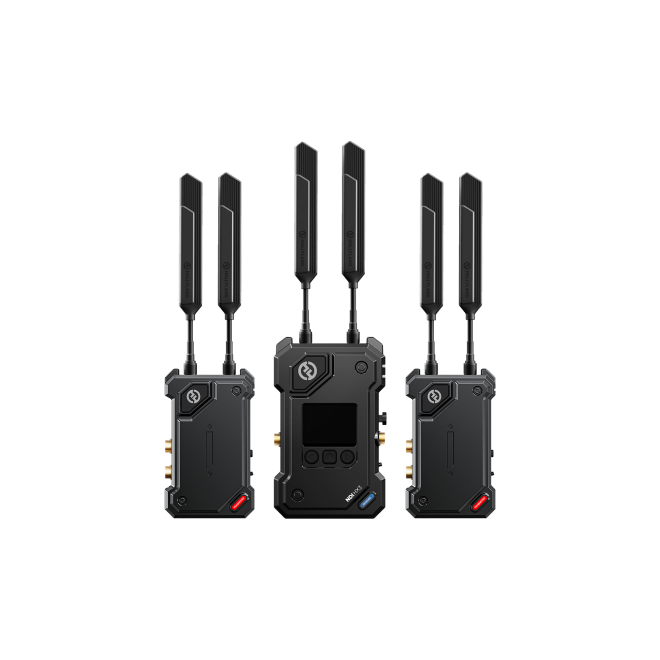
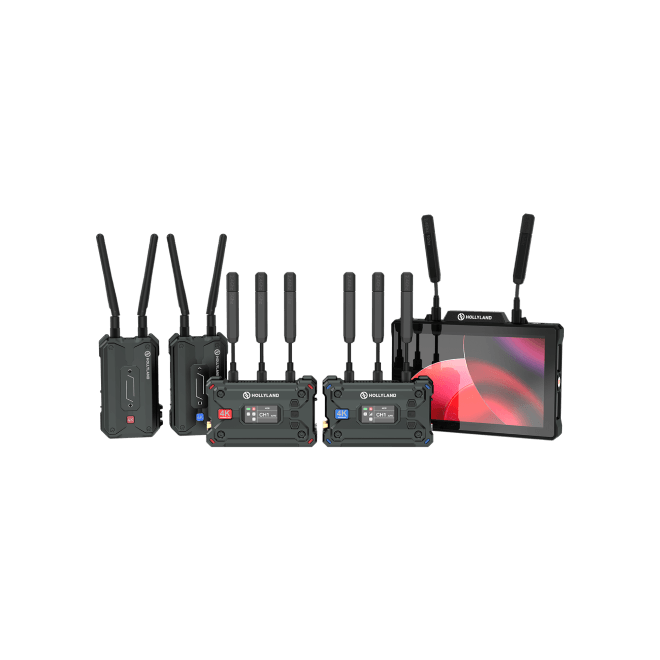
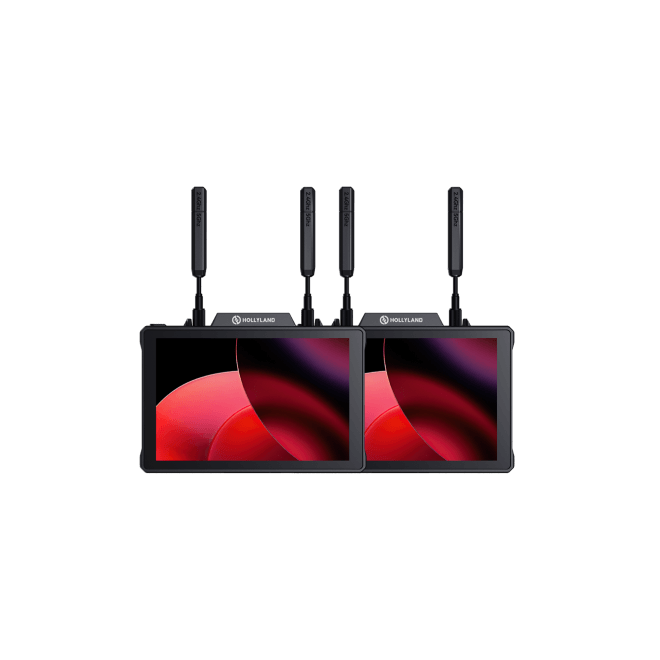
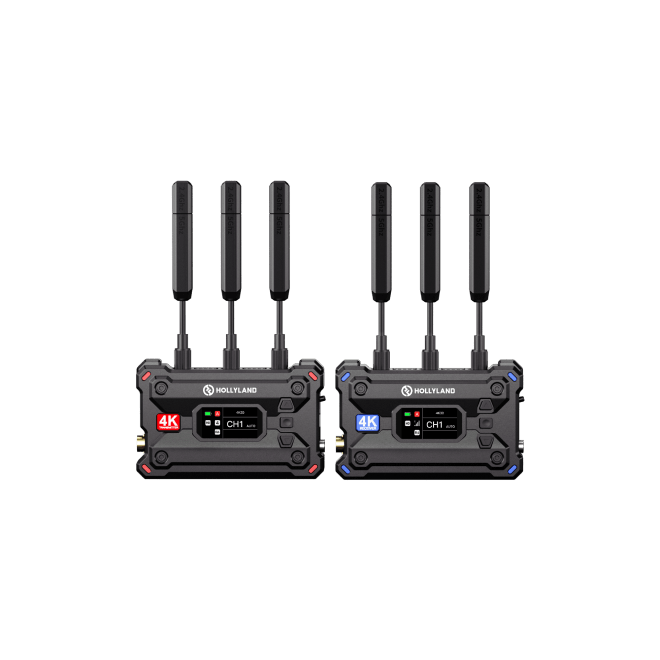
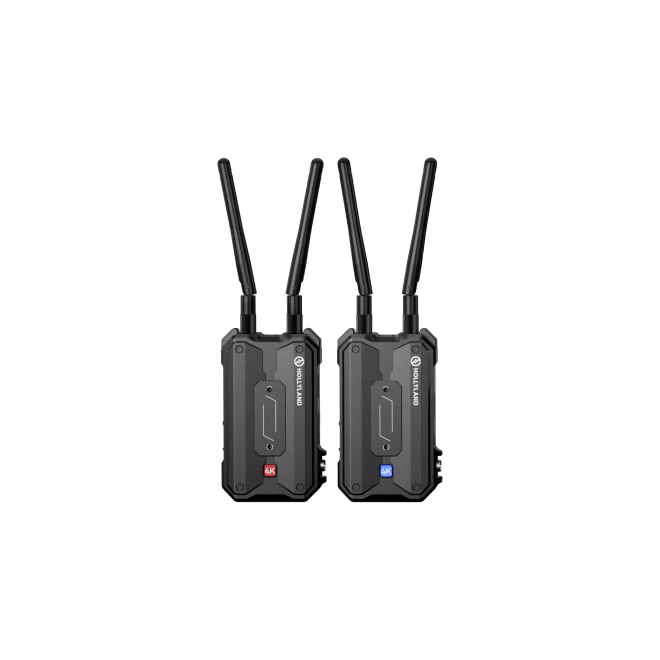
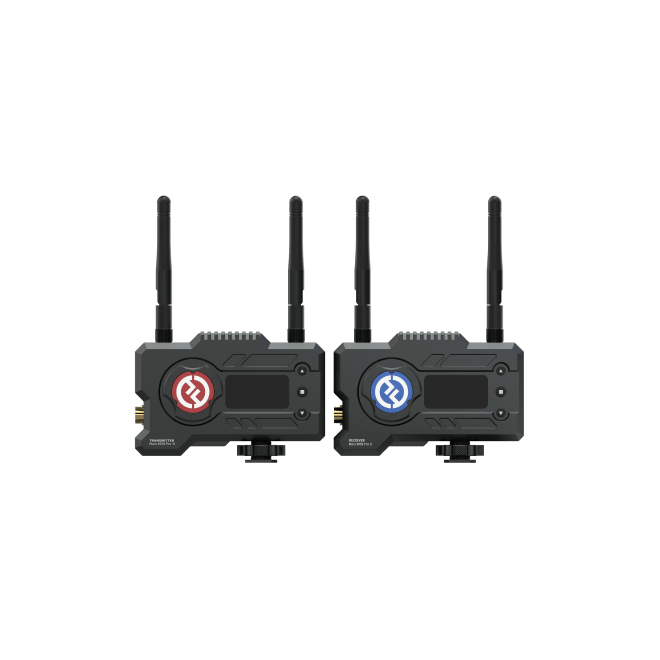
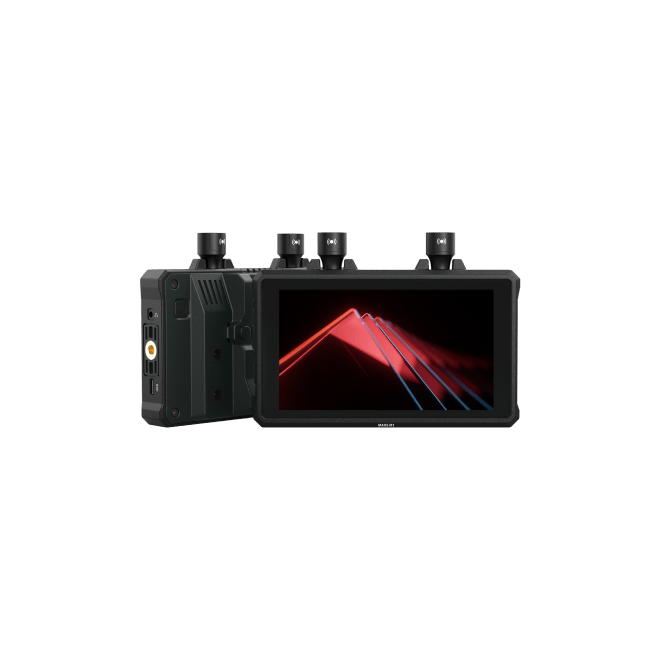
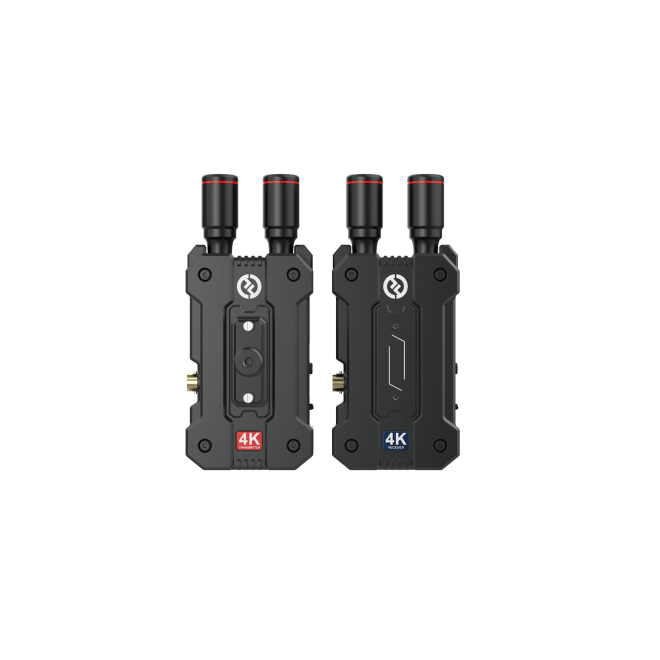
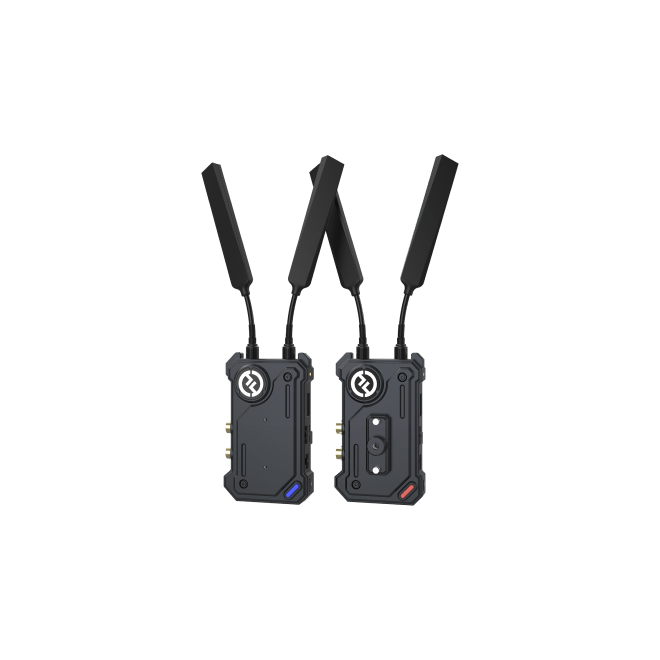
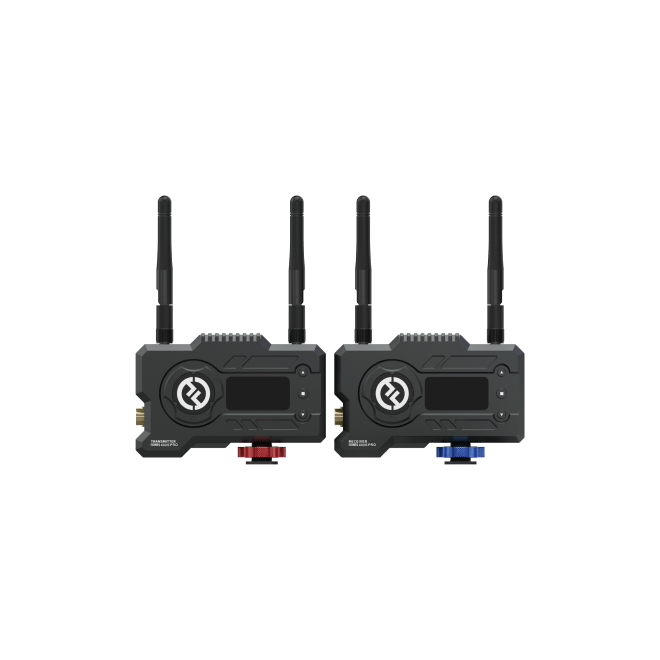
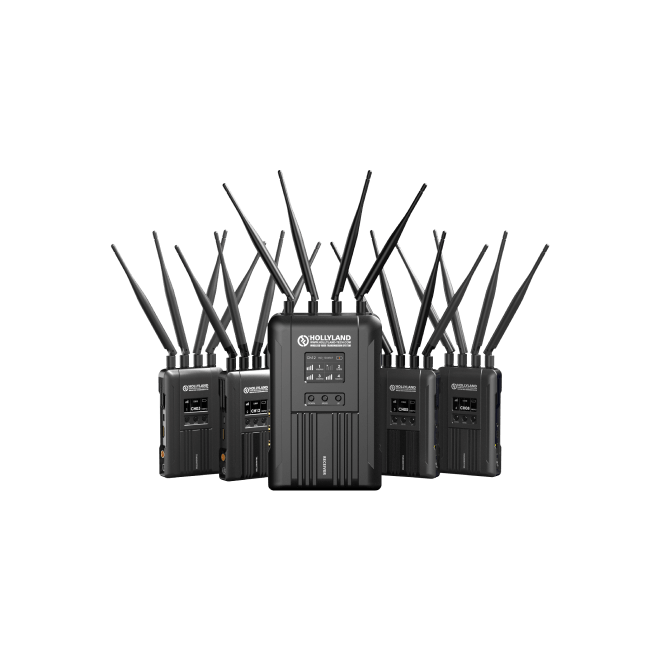

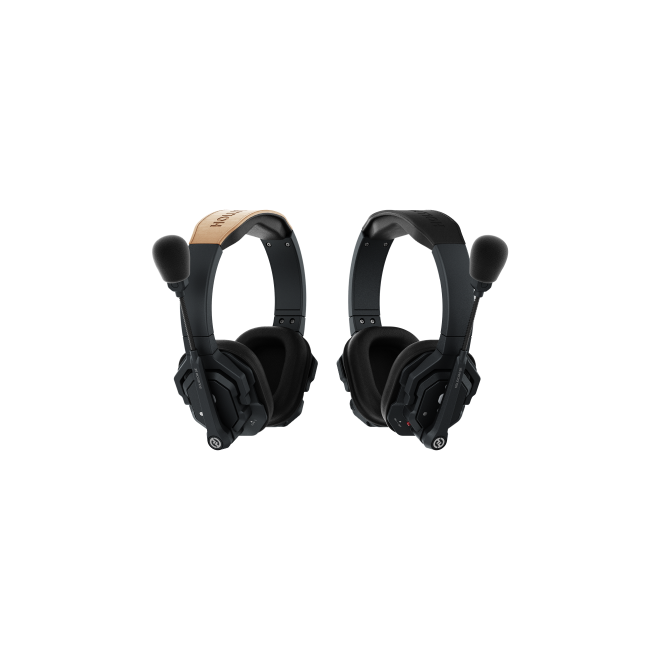
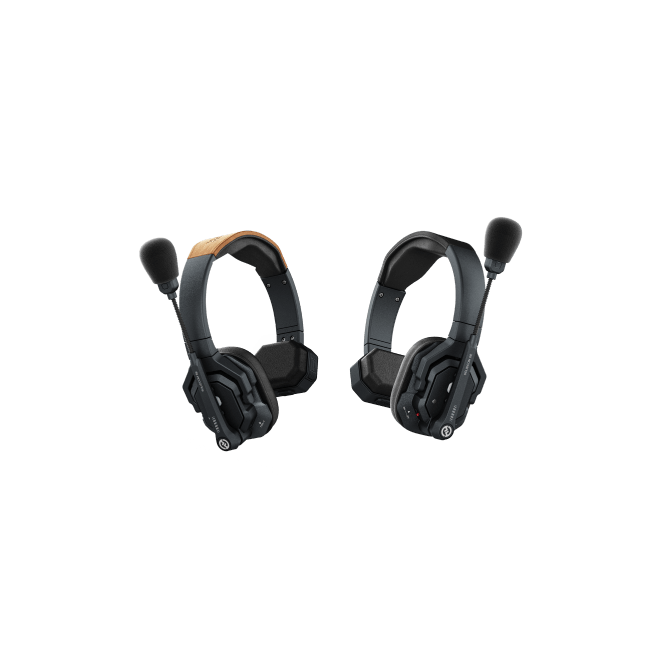
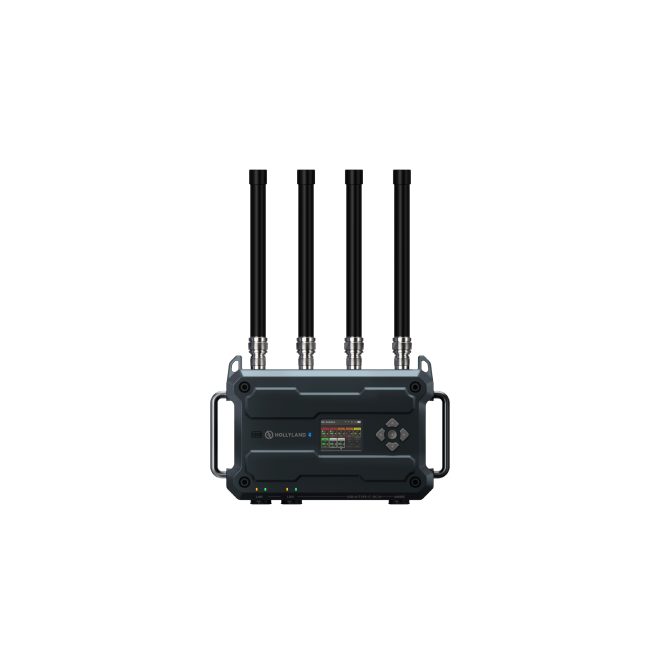
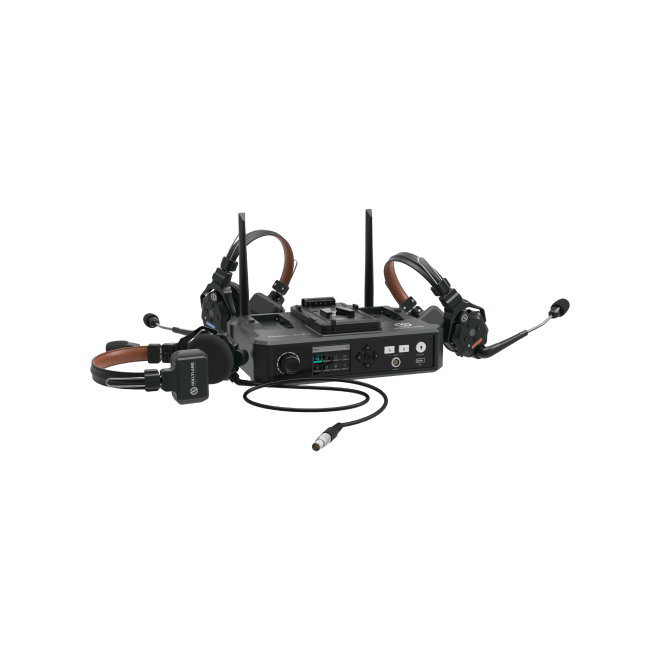
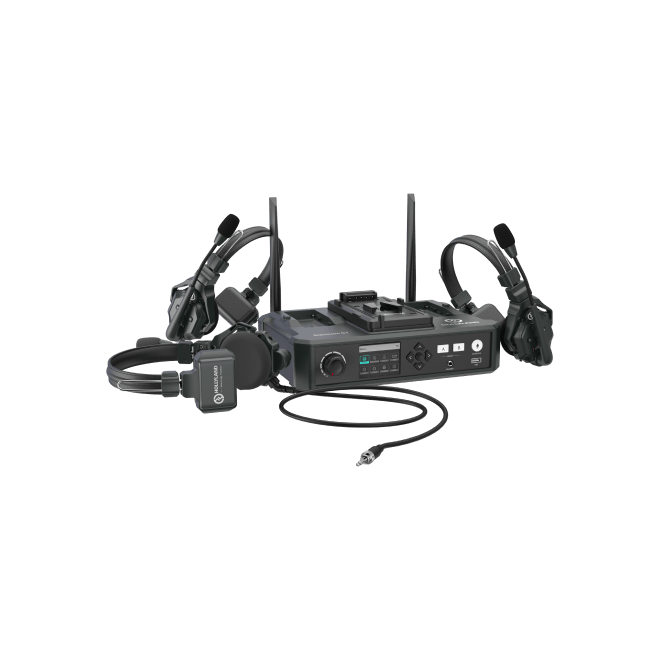
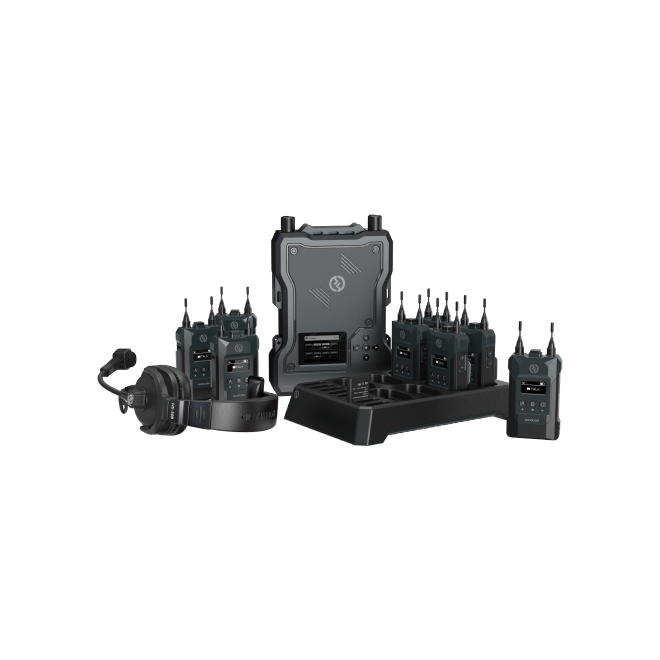
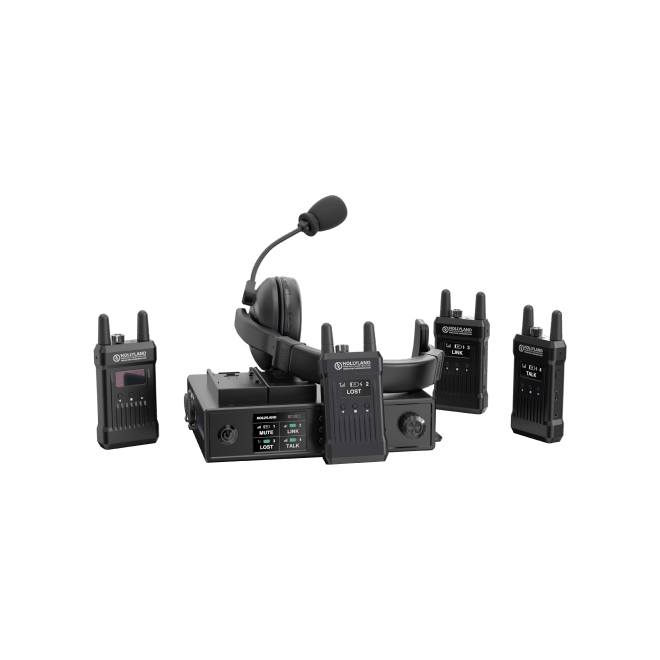
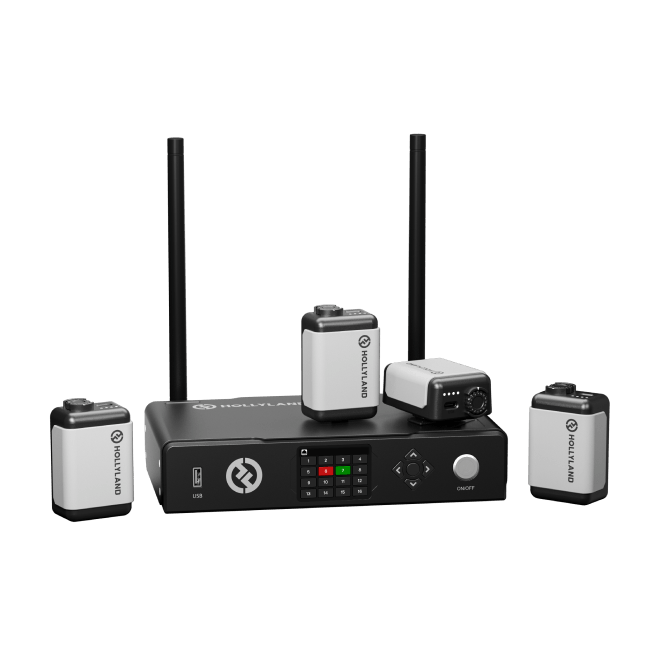
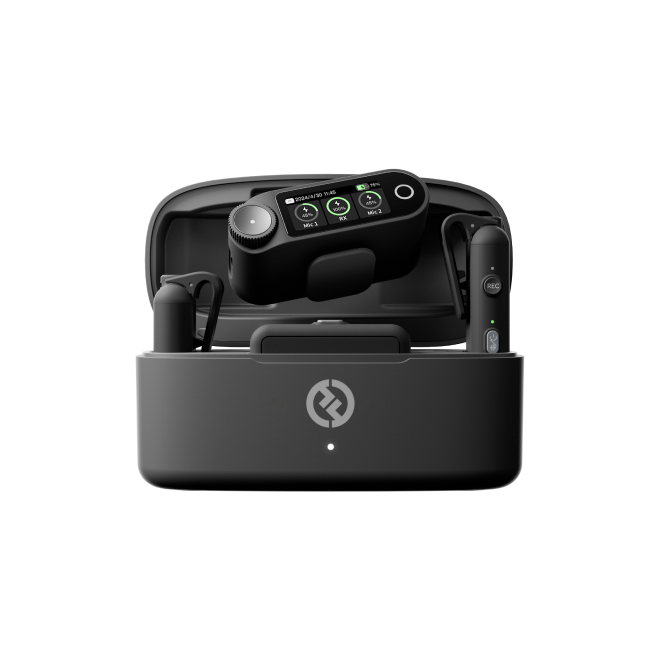


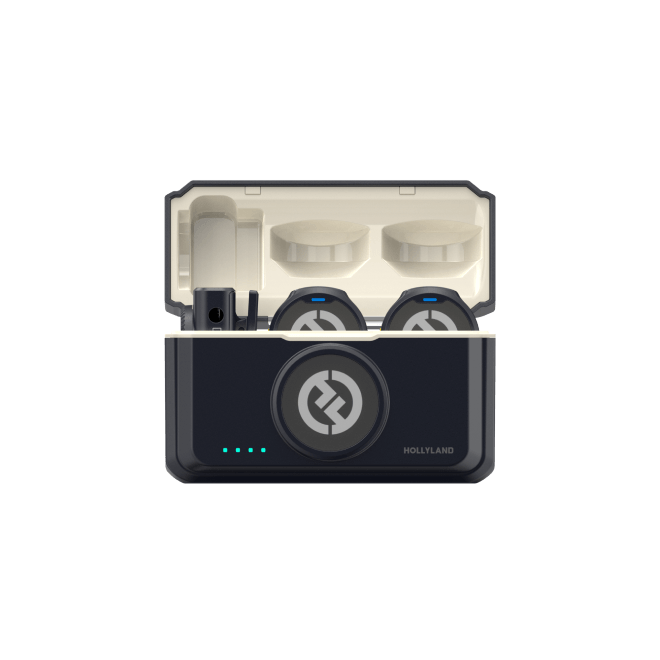
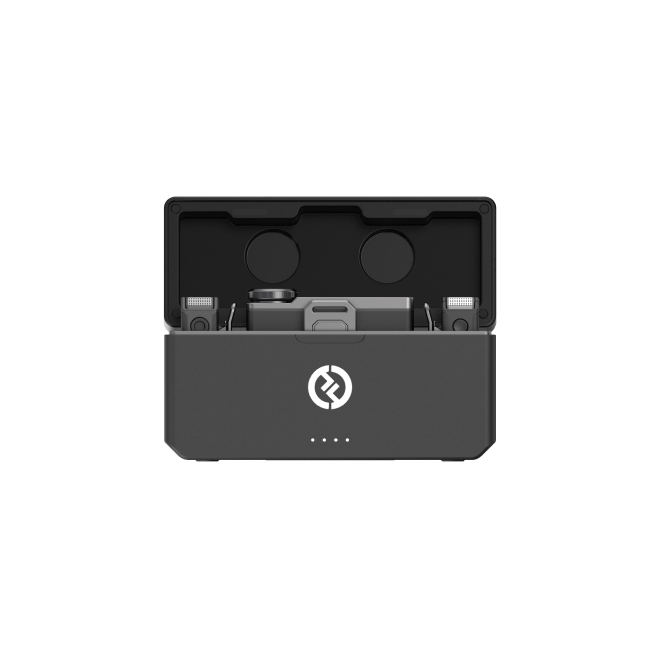
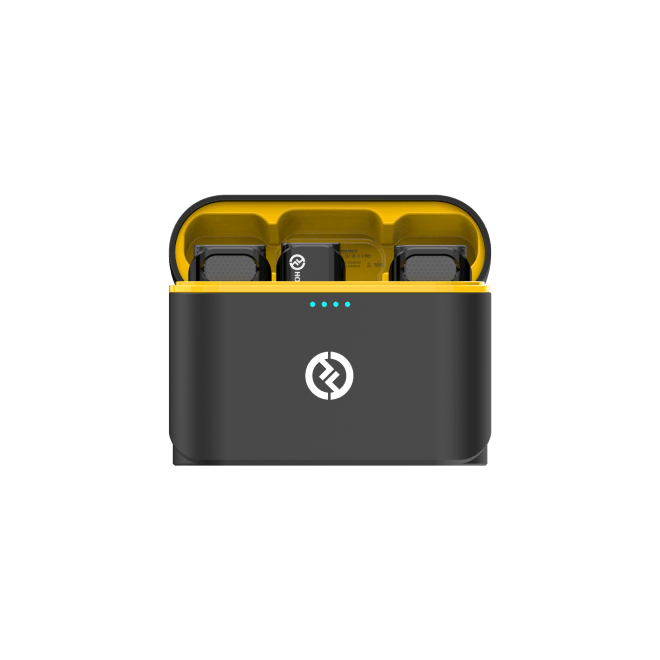
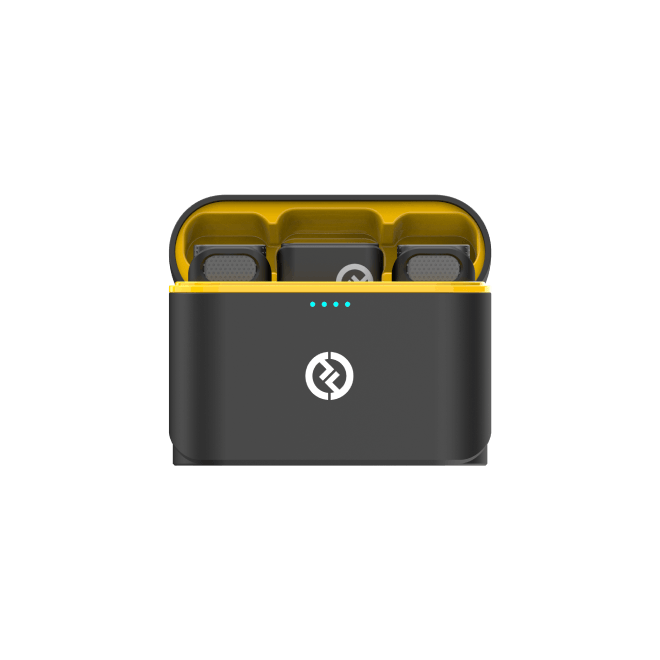
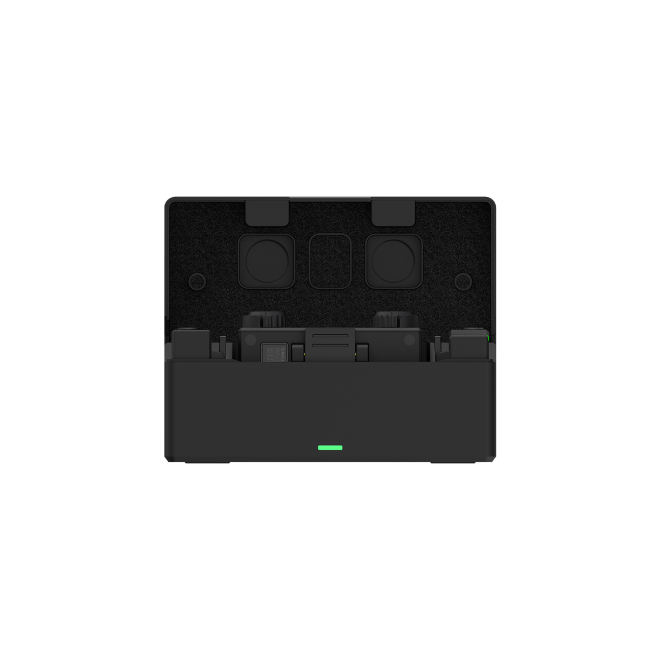
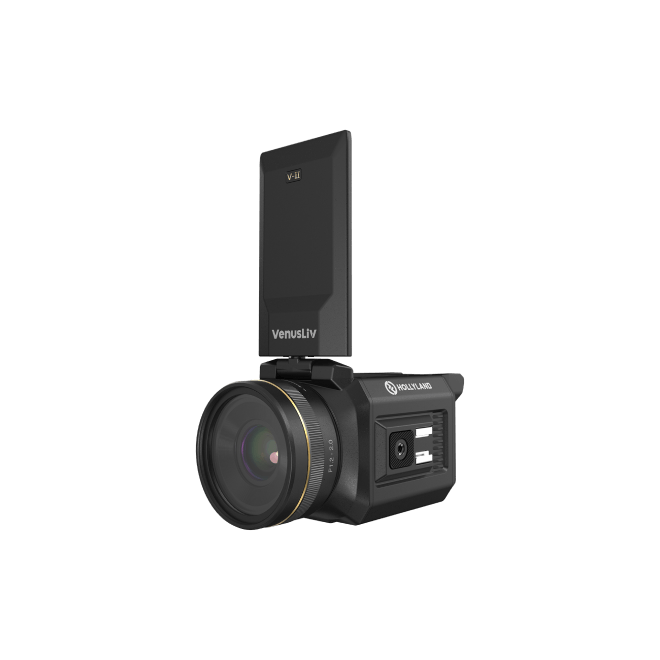
.png)


